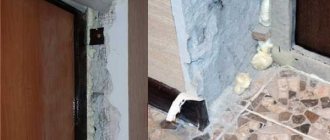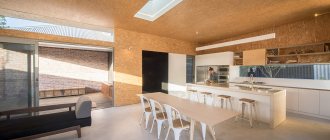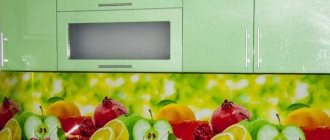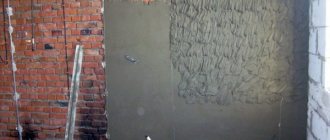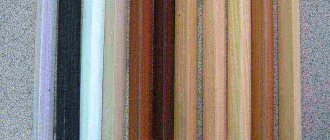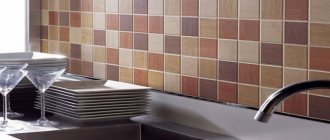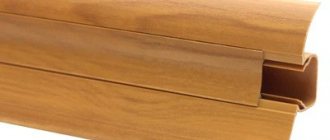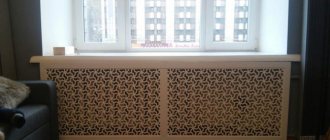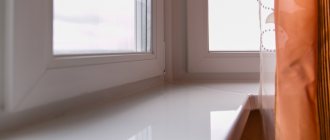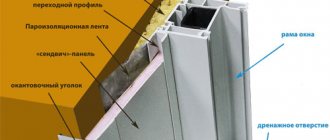How and with what to cover the wall behind a gas stove: general recommendations, tips
The place behind the gas stove and near the sink is the dirtiest. Therefore, it is worth considering a number of requirements for cladding in this place!
Behind the stove is the most important place in terms of cleanliness.
How to close the wall behind a gas stove:
- Every housewife who spends enough time in the kitchen knows what an important role this part of the kitchen space plays in everyday life. Therefore, it is so important that it is made of practical and beautiful material.
- By practicality in this case we mean strength, resistance to high temperatures and steam, easy cleaning and wear resistance. In such a way that after a short period of time this coating does not have to be changed.
- By beauty, of course, everyone understands something different, according to their personal tastes, needs and capabilities.
Focus on one thing at a time
But there are some small recommendations on appearance:
- It is better not to make the color scheme too light, since all the stains and stains will be visible on it. In general, try to make the “apron” darker than the façade of the kitchen itself;
- it should fit well into the overall interior. But remember the important rule - the emphasis is on one thing: either it is the wall behind the gas stove with a bright pattern, or it is the facade of the kitchen itself;
- The gloss looks nice, but all the fingerprints are visible on it. Matteness wins in this case, but there should be no roughness. Otherwise, all the oily steam will clog these small pores. But the glossy surface is still easier to clean;
- try to make more of the finishing materials themselves, and the seams between them are as small as possible. In this case, cover the grout with a special varnish, which will extend its service life.
Important: This is especially true for mosaics. It looks very beautiful in any kitchen, but many seams sometimes complicate and worsen the maintenance itself.
And here is the highlight of the apron
Also consider:
- In small rooms, huge drawings will look bulky
- But in a spacious kitchen, small patterns will be faded
- To expand the room, use horizontal lines; vertical - lengthen
- Also keep in mind that matte makes the overall picture calm and a little faded. Especially if there are no bright accents
- But gloss will help add brightness and colorfulness
- Make your own apron or screen with extra space. That is, it should extend 1-2 cm beyond the edges of the furniture
The illusion of a fireplace in your kitchen
Safety rules when choosing material
The most important thing in the design of a kitchen space is the correct choice of material for finishing the wall behind the stove, especially if the kitchen has gas equipment. In addition to splashes from cooking, this wall will be exposed to high temperatures.
Therefore, it is important that there is a heat-resistant material behind the stove. In this regard, ceramic tiles, glass, and metal have proven themselves well.
If the choice fell, for example, on MDF or PVC panels, then you should know that flammable materials cannot be installed in close proximity to gas burners, so that such a decision does not result in a fire.
Foam plastic, cork, chipboard, plasterboard and many others can be used as thermal insulation material. The choice will depend on your financial capabilities
Also, do not forget that it is highly undesirable to place a refrigerator next to a gas stove. If such a proximity is inevitable, then it is worth laying a heat-resistant partition between the devices.
Insulating material is placed between the refrigerator and the stove. Insulation can save refrigeration equipment from overheating, but will not provide protection from grease.
Protective screen 430/0.5 mm in Moscow
Protective screen 430/0.5 mm and other products in this category are available in the catalog of the Leroy Merlin online store in Moscow at low prices. Read the detailed characteristics and description, as well as reviews of this product to make the right choice and order the product online.
Buy products such as Protective screen 430/0.5 mm in the Leroy Merlin online store, having first checked their availability. You can receive the goods in Moscow in a way convenient for you; to do this, read the information about delivery and pickup.
You can always place an order and pay for it online on the official website of Leroy Merlin in Russia. For residents of the Moscow region, we not only have low prices for products such as “Protective Screen 430/0.5 mm”, but also fast delivery to cities such as Moscow, Balashikha, Podolsk, Khimki, Korolev, Mytishchi, Lyubertsy, Krasnogorsk, Elektrostal , Kolomna, Odintsovo, Domodedovo, Serpukhov, Shchelkovo, Orekhovo-Zuevo, Ramenskoye, Dolgoprudny, Pushkino, Reutov, Sergiev Posad, Voskresensk, Lobnya, Ivanteevka, Dubna, Yegoryevsk, Chekhov, Dmitrov, Vidnoye, Stupino, Pavlovsky Posad, Naro-Fominsk , Fryazino, Lytkarino, Dzerzhinsky, Solnechnogorsk, Istra and Zhukovsky.
Suitable options
In accordance with the above requirements, today there are three most common options for manufacturing protective screens for the kitchen, in which, most often, not one material, but a whole combination of them is used to obtain the greatest efficiency.
Option #1: MDF (Medium Density Fiberboard)
Medium-density fiberboard itself, despite the presence of some moisture resistance in the areas where the gas stove and sink are located, will not last long. Therefore, when talking about MDF screens, we mean one of the following combinations of this material with plastic:
- MDF plus PVC film . Such an apron is not the most successful from an operational point of view, since the PVC coating tolerates the negative effects of excessive humidity and high temperatures even worse than the medium-density fiberboard itself. But there are several advantages due to which this type of finish is still used in the kitchen:
- Relatively low cost;
- Imitation wood , which looks good in combination with a wooden kitchen set;
- Easy to create a hole for exhaust if necessary. MDF is very easy to cut;
I recommend using a PVC-coated fiberboard only when you have an electric or induction stove instead of a gas stove, since the presence of an open flame nearby can very quickly damage the PVC film.
- MDF plus acrylic film . In fact, we are not talking about film here, but about decorative paper impregnated with acrylic resins. In this case, there are more advantages, although the cost of the finished product is also higher:
- Availability of glossy shine and rich bright color;
- UV resistance;
- Acceptable moisture resistance;
- MDF plus acrylic plastic . Such an apron will cost even more, but it will be able to withstand all the hardships of kitchen life, as it has a number of important advantages:
- Resistance to dampness;
- High temperature resistance;
- Resistance to mechanical stress;
- The ability to imitate wood, stone, steel or even leather.
I do not recommend using abrasive detergents to wash acrylic surfaces, as they may leave unsightly scratches.
The installation instructions for such screens look extremely simple: just apply liquid nails to the back of the panel, and then glue it to the wall.
Option number 2: plastic
A protective screen made of plastic can be painted in some color, or it can be simply transparent, imitating glass. Pros:
- Low cost . Plastics have always been cheap;
- A light weight . Installation is simplified and there is no load on the wall;
- High water resistance;
- Transparent models have additional decorative options . In this case, the plastic panel plays the role of a screen, behind which you can place paper or even fabric wallpaper.
Photo wallpaper is behind a transparent plastic apron and is not subject to the negative effects of dampness inherent in kitchen areas
But there are also disadvantages:
- Low melting point . When heated to +80 degrees Celsius, the plastic already begins to deform;
- Relatively low resistance to mechanical stress.
Option No. 3: glass
Glass screens boast the greatest number of positive aspects, which include:
- High strength and wear resistance . We are talking not just about glass, but about skinal, which is a hardened version of this material. It is very difficult to scratch or break it;
- Beautiful appearance with the ability to print photos directly on the glass surface;
A glass protective screen with photo printing can decorate any kitchen.
- Chemical inertness;
- High hygiene;
- Excellent resistance to high temperatures . Easily tolerates proximity to a gas stove.
- High price;
- Need for constant care.
Wall protection for gas stove
A protective screen, to put it simply, is the same as an apron, only larger. The main requirements for wall protection include:
- stable condition to high temperature and humidity;
- have a high degree of wear;
- the ability to simply clean the surface;
- beautiful and aesthetic design.
Such products are made from PVC film, on which a decorative pattern has already been applied. Such stickers are inexpensive, so if damage occurs, the surface can be refreshed. This is the most budget option for using the screen. If you want to make it durable, you need to choose durable and high-quality materials.
No. 1. What materials can be used to finish the apron?
To all the requirements for the material of a kitchen apron described above, it is worth adding that it must have the smoothest possible surface and be low-porous . Due to this, the ability of the material to absorb moisture is reduced, and the ease of maintenance, on the contrary, increases.
Today, the following materials are used to organize an apron:
- ceramic tile;
- mosaic;
- glass;
- PVC panels;
- natural and decorative stone;
- MDF panels;
- metal;
- plaster, paint and other materials.
Each of these materials has its own advantages, disadvantages and features, and below we will dwell on the characteristics of each of them.
In conclusion
A kitchen apron is regularly exposed to negative influences: splashes of water, drops of fat and various products, high temperature, frequent washing. All this makes us look for the most practical and resistant material to all this. Everyone wants the kitchen to be attractive, stylish and harmonious, so another requirement is put forward for the finishing material - a pleasant appearance. In addition to ceramic tiles, there are many other ways to decorate a kitchen working wall: when choosing one option or another, it is important to compare all the pros and cons, think about how the material fits into the kitchen conditions, and only then make a decision.
Tags:Kitchen
No. 7. MDF panels: a budget and practical option
You can make a kitchen apron from MDF panels: it will not cost much, but will be much more practical than finishing it with film or PVC boards. The main advantages of this method of finishing a working wall:
- moisture resistance and strength;
- quick production , because, as a rule, such an apron is created together with a kitchen set;
- ease of installation . The walls do not require careful preliminary preparation, and the panels can be fixed either to the frame or using liquid nails. If you need to replace the apron, this can be done very simply - you don’t even need to remove the furniture;
- seamless coating , and this is important in a kitchen work area;
- beautiful appearance : such panels can imitate ceramic tiles, stone, wood, brick, and recently a bright pattern has been applied to the material so that the apron becomes a real highlight of the kitchen.
But the material, unfortunately, has disadvantages:
- Not all detergents be used to clean the surface . Too active substances can negatively affect the material, ruining its appearance and performance;
- flammability , so it is better to use MDF panels only in kitchens where an electric or induction stove is installed.
Liquid soap
If you don’t have the time or desire to mix different components, you can simply apply a layer of liquid soap to the work surface. All the fat that gets on the stove during the cooking process simply will not have time to burn, so the surface can be easily washed off with a regular sponge. The role of the detergent will be performed by the previously applied liquid soap; you just need to rinse everything thoroughly with water.
Of all the listed methods, any housewife will find a suitable option for herself. These little tricks will help you forget forever about a thick layer of burnt fat and long cleanup after cooking dinner. At the same time, money will remain in the budget that was previously spent on purchasing many products for cleaning the stove.
No. 8. Natural and artificial stone
Natural stone is used extremely rarely to organize a backsplash, but if it is used, it is often granite. Although the material is moisture resistant and can withstand high temperatures, it is heavy and expensive and requires special care. Often a stone apron is created as a continuation of a stone countertop.
An alternative to natural stone is an artificial analogue , which is inferior only in terms of strength, but outperforms in all other characteristics. Artificial stone can imitate any type of natural stone; it looks great in the interior. In addition, it is moisture resistant, can withstand high temperatures, stains of grease and various foods will not leave a trace on it, and in terms of care it is quite simple. Its price and weight are significantly lower than that of natural stone, so a working wall can be safely finished in a similar way.
Screen materials
Below are the most common materials used to make slab screens. Laminated board made from MDF and chipboard materials is a budget option, but not so durable, the wear resistance of the protective film is quite low. Service life up to 5 years.
You can get out of this situation if you find a factory for the manufacture of entrance doors, where they will apply a special coating that is highly fire resistant and easy to clean even with abrasives and scrapers. It will not be as elegant, but durable. As a rule, it is just a screen of one color or a high-quality imitation of wood.
Artificial stone or porcelain stoneware
The product made from these materials is highly durable: resistant to large amounts of moisture, easy to clean, and can be used for many years. The downside is that the surface is not completely smooth, so dirt can get into the seams. Each type of composite material has its own individual properties.
- Artificial stone can be easily scratched by a metal object. However, this problem can be quickly corrected by sanding the surface with a power tool.
- Acrylic surfaces cannot withstand temperatures above + 80°C, so it must be attached as far as possible from the stove.
- It should be noted that porcelain stoneware and artificial stone will look aesthetically pleasing if the design and color of the countertop is harmoniously combined with the screen.
Metal
The metal is usually stainless steel. It perfectly protects walls from fire. However, otherwise there are more minuses than pluses. For example, such screens are thin, so they are easily deformed or pressed through. On such a surface traces of water or grease are visible. Another problem is that the metal sheets are attached to moisture-resistant plywood and secured to the wall. This substrate releases substances harmful to human health.
Tempered glass (triplex)
This is quite expensive, but a stylish and durable solution for the kitchen. If you make it as an apron, then you need to order it according to the individual dimensions of your kitchen. For the screen above the gas stove, standard versions from the store, made with fasteners, are also suitable. However, such a part will still be quite expensive in cost, but the most practical of all the materials presented above. As a rule, the standard thickness for such screens is 6-8 mm. Although these are small sizes, however, the thicker the glass, the more it begins to “green”.
If the screen does not match the planned style of the kitchen, then you can apply a beautiful design to the surface of the glass.
Protective screens near or around the oven
Such a system will need to be implemented when installing a potbelly stove in the corner of the room. You can mount or lay out several screens from brick, installed at a short distance from each other. In this case:
- The first screen protects a person from touching the iron stove and getting burned. It is usually made of refractory or fireclay bricks;
- To protect walls made of flammable material, a second layer of protection is provided. It can be made of brick or covered with a barrier made of sheet steel with a mirror-like front surface. In this case, heat waves will be reflected from the mirror and spread faster throughout the room;
- if the foundation is insufficient in size or it is impossible to manufacture it, it will be necessary to lay a protective screen made of durable fire-resistant material on the wooden floor. This can be a sheet of steel or a decorative layer of heat-resistant clinker tiles or porcelain stoneware. The surface will first have to be covered with a layer of thermal insulation.
Installation of metal screens
This is the easiest way to make surface protection. It is better to use sheets with a polished front surface. Before fastening, the wall surface at the required level along the height of the screen is covered with a layer of thermal insulation. In this way, we protect the surface of the walls from the effects of heat.
You can lay a layer of thermal insulation or fasten the metal with self-tapping screws with inserted ceramic spacers. But it is better to attach the screen to strips or a metal profile treated with a layer of protection. In this option, the air gap will not allow heat to pass freely to the walls, and reliable insulation of the stove from the wooden wall is ensured.
A special gap is made at the bottom of the wall for the passage of cold air, ventilation of the wall and screen. When arranging a wall with a layer of thermal insulation, a number of longitudinal guides are installed on the surface. The space between them is filled with a layer of mineral wool or other material. Then sheets of metal are installed and screwed to the sheathing with self-tapping screws.
In this design, there is no need to leave a gap at the bottom. The air will not be able to pass through calmly, but the wall will be reliably protected from high temperatures. To protect the floor of the house, a slab made of non-flammable durable material can be used.
Brick screens
This protection option is usually installed near the stove. Thus, you can protect not only the wall, but also the person from burns. By installing a brick wall, you can reduce the distance from the stove to the wall. For laying, it is better to use ceramic or fire-resistant bricks.
The work is carried out in several stages:
- you will need to make a small foundation or remove boards from the floor along the marking lines for laying the screen and, by drilling holes in the concrete of the base of the building, insert metal rods to fasten the bottom of the wall and the foundation;
- Having leveled the floor surface, lay out a layer of mortar and lay the first row of bricks; you need to place the bricks in the same plane without distortions. This determines how level your entire wall will be. Do not forget to make small grooves for ventilation; for this you can move several bricks of the bottom row.
- checking the level and pulling the twine for laying each subsequent row, all bricks are laid on a mortar of clay and sand. Having raised the wall to the required height, the top is sealed with a layer of mortar or covered with a board. This way you can make a shelf for decorative ornaments and all sorts of little things.
The brick is laid no higher than the top of the furnace at a distance of at least 40-100 mm from it.
Using both types of protective screens, you can reduce the distance from the oven to 500 mm.
Examples of installation of protective brick screens in the photo:
I stopped cleaning the kitchen every day. I’m sharing how to protect the stove and walls from splashes
Having moved to a new kitchen, the first thing I was concerned about was keeping it clean. In the first two days we managed to do a little work on the furniture and hob (steaks!). I had to take the time to wash the kitchen and the tiled wall. Then I went looking for ways and reviews on how to protect the stove from splashes.
The cleanliness of the stove when cooking has worried me for many years. I tried many devices, and none of them suited me 100%. Therefore, I chose to protect the stove from grease without much inspiration.
Looking ahead, I will say that this time I was able to select accessories that save surfaces from contamination. After frying, I didn’t need to wash the entire kitchen, which made me very happy.
I decided to write reviews about all the previously tested splash suppressors, protective plates and screens for stoves. And you decide for yourself what to choose. For some, my disadvantages may be insignificant, or they may be advantages.
Choosing a reliable and durable kitchen screen
The screen is the closest relative of the kitchen apron, which performs the same protective functions as the finish above the worktop. But it always ends up in the hottest spots, taking on the heat and soot of the hob, and sometimes splashes from the sink. In fact, the usual apron is a screen, only it has grown noticeably and occupies the entire wall along the work area. So the only difference between the two is size.
- Primary requirements
- Laminated MDF or chipboard
- Triplex or tempered glass
- Porcelain tiles, artificial stone
- Metal
Features of stove covers
Many housewives believe that a gas stove cover is an important component of a kitchen set. It can protect walls from splashes and dirt. Iron and glass lids are often used. Iron ones are distinguished by their wear resistance, can withstand high temperatures, and can be cleaned with various detergents, even harsh ones. Glass lids are less resistant to high temperatures, but you can stick interesting pictures on the glass and change them more often. You can make a glass lid yourself. To do this, you need an aluminum corner, two glass curtains, they can be bought in furniture stores. The glass must be cut to fit the size of the lid and polished. Then we temper the glass, the lid is ready.
No. 6. PVC film - temporary solution
If you need to make quick and inexpensive temporary repairs, then it makes sense to take a closer look at PVC film. For a while, just before you do normal repairs, it can serve normally. Its main advantage is low cost . In addition, the range of colors of such films is simply huge: natural materials, landscapes, ornaments, etc. You can handle gluing such material yourself; the film is resistant to mechanical damage, but that’s where its advantages end.
This material can gradually fade under the influence of sunlight, it is afraid of high temperatures, and if damaged it cannot be restored. It can be used as a temporary kitchen decoration, but is not suitable for permanent use.
Communications
New and well-laid pipes and good plumbing are the key to the absence of breakthroughs. In any case, make it possible to easily and quickly access the communications under the sink and install additional valves there so that in case of emergency the water can be quickly shut off in this particular area.
If the apartment uses gas, entrust the replacement of the hose and connection of the stove to a professional. If you decide to replace it yourself, lubricate the joints with soapy water to make sure there are no bubbles and no leaks.
Electrical is also very important. It is ideal to connect the entire kitchen to a separate machine, that is, isolate it from the rest of the wiring in the apartment. Many appliances, such as electric stoves and ovens, dishwashers, some microwaves and even kettles require a power cable. Be sure to consult with an electrician to understand which devices can be combined into one network, and which ones will lead to overload and the plugs will constantly be knocked out. Place external sockets away from the sink and stove.
Kitchen set
When planning a kitchen set, you need to maintain the minimum permissible distances between electrical appliances and water sources.
If you are making a kitchen to order, the specialist will have to take them into account. If you are planning a purchase, for example, from IKEA and use their kitchen planner, there are text tips there. Read my personal experience of planning a kitchen at IKEA here. Basic principles: Do not place a stove and refrigerator in close proximity, or a stove and a sink. It is also recommended to make a spacer between the oven and the dishwasher.
Cabinets cannot be hung above the stove unless they contain a built-in hood. For the hood to work effectively, it must be placed at a distance of 70-75 cm (electric stove) and 75-80 cm (gas stove). It is not advisable for the corners of the hood to protrude in front of the wall cabinets; there is a risk of constantly hitting your head against them.
If you are attaching wall cabinets to modern, solid walls, use fasteners recommended by the manufacturer and no problems will arise. Old walls of Stalin and Khrushchev buildings may need additional fastening
Pay due attention to the fasteners, even if you are hanging open shelves - each of them has a maximum weight that they are ready to withstand. If overloaded or not fastened firmly enough, the shelves may collapse, and that would be good, if not on someone’s head.
The height of the wall cabinets depends on their depth and the height of the person who will cook. The optimal distance is 45-55 cm from the tabletop. A lower placement will cover part of the countertop. Deep cabinets especially need to be hung higher, but within sight, so as not to hit your head on them when bending over the work surface.
Before ordering a custom kitchen, to be on the safe side, draw out all future elements directly on the wall. When applying cardboard of the required width, see what the depth of the elements will be and whether it will be comfortable for you. Because in this case, it is comfort that ensures safety.
Laminated MDF or chipboard
A budget-friendly way to cover the kitchen wall behind the sink and hob, but also short-lived. The lifespan of such a plate barely reaches five years, and the protective film does not have sufficient wear resistance. But you can buy a 6 mm thick panel with a pattern already applied to it for only 1900 rubles/m2.
However, an alternative option is now available: look for a workshop for the production of entrance doors, where they can apply an anti-vandal decorative coating to a regular MDF sheet. It is fire resistant, easy to clean from difficult stains and certainly will not be scratched by a kitchen scraper.
Don't expect any special artistic delights, but in some kitchens a plain screen or a skillful imitation of wood looks quite decent.
Triplex or tempered glass
The other extreme is a stylish and expensive glass screen, which in the kitchen can last longer than the furniture itself. You will have to order its production individually according to your dimensions if you want to assemble a large, full-fledged apron. But for a compact screen, only for the section of the wall above the stove, it may be possible to buy small standard panels with eyelets for fastening. But in general, the cost remains the same - 6-7 thousand per square. But in terms of practicality, this finish has no equal.
Keep in mind that for a protective screen, the optimal panel thickness is 6-8 mm.
This seems small, but with such dimensions the glass is already beginning to have a green tint. If this shade is not suitable for the chosen style of kitchen interior, you will have to buy lightened or, on the contrary, tinted panels. But more often, customers prefer glass screens with a beautiful pattern printed on the back.
Although glass screens are among the most expensive and may well exceed the cost of some types of artificial stone, from a practicality point of view they are the best solution for the kitchen.
And their price in comparison with durability will no longer seem to you a serious drawback and an unjustified waste of money.
Photo
Don't be afraid to experiment. The apron can be made from decorative stone panels, marble, natural pebbles, super washable wallpaper, brick and even wooden clapboard. The main thing here is to take into account certain areas, for example, near the slab you can apply glass as a separate element, on top of wallpaper or the same brick. Natural wood materials can be additionally treated with durable varnish, and a lot of other techniques can be used that will increase practicality and durability.
The interior of your kitchen can be very whimsical and individual, the main thing is not to be afraid and take action, and practical advice will help you implement your own ideas correctly and without mistakes. There is no friend according to taste and color, and if you suddenly decide to implement an interesting idea, then go towards your goal by combining and combining various building materials.
What could the design and color be?
It is logical that the design of the apron directly depends on the design of the kitchen as a whole. A bright accent on this area with a neutral interior will look at least inappropriate. Therefore, when choosing:
- focus on the color of your facades, floors, curtains or countertops;
- avoid an overly grainy texture - it is extremely difficult to care for;
- Be careful with shades of black - water droplets and grease are especially noticeable on such a surface.
Our articles will help you decide on a color choice: 105 of the most stylish kitchen interiors in gray tones 143 fashionable beige kitchen interiors 120 photos of the most beautiful white kitchen interiors 109 fashionable kitchen interiors in blue tones
Very often, the apron is made in the same vein as the tabletop: the same material and texture, identical motifs. Differences may be in color intensity: a tone lighter or, conversely, darker. The white version, as in the photo below, is among the most common.
The opposite case is when a darker apron becomes a noticeable accent in a neutrally decorated room. Largely due to the integration of stone texture. Along with wood, it is appropriate for almost any kitchen.
Another way to beautifully highlight a backsplash is with an artistic panel. It is made from
- plastic;
- glass;
- ceramic tiles.
You have complete carte blanche to choose the type of image. True, appeals to kitchen themes (food, fruit, glasses, coffee, cups, plates) are among the most frequent.
For loft and high-tech it would be appropriate to preserve the “native” concrete texture. But you still have to prepare it: for example, varnish it, so that later you don’t have to spend hours (and unsuccessfully!) washing the walls from dirt and grease stains.
Owners of small kitchens can use a little trick and use an apron with horizontal lines. You will get an interesting optical effect of expanding space. Both striped plastic panels and popular ceramic subway tiles are suitable. It is also often called a “hog” due to Soviet custom.
You will find more options for designing a kitchen backsplash with boar tiles here.
Wallpapering yourself
Wallpaper is the most budget-friendly finishing option, so most often the finishing is done independently. Let's take a closer look at this process.
You will need the following set of tools:
- tape measure and wooden meter;
- calculator;
- pencil;
- construction spatula;
- perforation spatula;
- scraper;
- wallpaper scissors and knife, wallpaper cutter.
Necessary tools for wallpapering.
Almost everyone knows how to glue wallpaper, but not everyone knows how to do it correctly. Our instructions will help you avoid mistakes.
Preparing the walls
- We remove the old layer of finishing material. To make old wallpaper come off better, you need to first moisten it with a soapy solution and add wallpaper glue.
Tip: If your walls were previously covered with washable wallpaper, then you need to make slits in them. This way the base will be more likely to be saturated with the solution.
We prepare the wall for pasting, remove the old wallpaper.
- We wait until the wallpaper gets wet and remove it with a metal spatula. If necessary, repeat the procedure.
- If you have previously used vinyl two-layer wallpaper, then make horizontal cuts and remove the top layer. The bottom layer, if it holds well, is not removed, as it can serve as a good foundation for us.
- If the walls were painted with enamel or oil paint, then before wallpapering, we clean the surface with coarse sandpaper. Water-based paint is pre-soaked with a soap solution and removed with a spatula.
- We plaster and putty the walls to eliminate cracks, unevenness and other defects.
We putty the walls.
- If you are covering walls with thin paper wallpaper, it is recommended to first cover the surface with facing paper.
Let's start wallpapering
- Roll out the wallpaper face down. We measure the height of the wall on them and add 10 cm. If the pattern allows you to glue the wallpaper without joining, then you can immediately cut several strips. If docking is necessary, we add a tolerance. As a rule, the manufacturer indicates it on the packaging. Please note that the consumption of wallpaper in this case increases.
- We mark a straight vertical line on the surface using a plumb line - it will serve as a beacon for the first strip of wallpaper.
- Apply glue to the wallpaper from the middle of the strip to the edges and leave it for 5 - 10 minutes, depending on the thickness of the paper.
Apply glue to the cut piece of wallpaper.
- When using heavy wallpaper, it is necessary to coat the wall as well. If you use non-woven wallpaper or glass wallpaper, then the glue is applied not to the wallpaper, but to the walls.
Lubricate the wall with glue.
- Glue the wallpaper, aligning it along the intended line. We glue all subsequent strips end to end. Lightweight wallpaper can be glued overlapping.
We glue the wallpaper onto the wall and cut off the excess pieces.
- Press the glued strip with a dry, clean cloth or roll it from top to bottom from the middle to the edge with a roller. We cut off the excess edges at the top and bottom with a sharp knife immediately, before the glue has time to dry.
Paste over the inner corners
A common mistake that many people make is to cover a corner with a whole strip of wallpaper. As a result, folds or mismatches are formed if the angle is uneven. To prevent this from happening, measure the distance from the glued strip to the corner and add 20 mm.
Wallpapering.
We glue the wallpaper and run the blunt side of the knife along the corner so that the paper fits tightly.
Wallpapering the ceiling
- Mark the border for the first strip of wallpaper.
- Lubricate the canvas with glue. We apply it to the ceiling and align it along the drawn line (photo).
We glue the wallpaper to the ceiling.
- We press the wallpaper to the surface and straighten the folds.
No. 11. How to organize a kitchen apron in an original way?
A kitchen apron can be finished with paint or plaster , naturally, with maximum water resistance, but if you cook something more or less often, then this option is not suitable, especially when it comes to light-colored finishes.
In addition to all the ways to organize a work wall described above, there are also a lot of unusual, creative options that will highlight your individuality and make your kitchen unique. Here are just a few of them:
- use broken and whole pieces of ceramic tiles and dishes . First you will need to lay out all the fragments on the floor or on the table, and then carefully mount them on the wall. It comes out stylish and original;
- remnants of parquet can also be useful. It is fixed on a sheet of moisture-resistant chipboard, for example, in a herringbone pattern, and a panel of transparent tempered glass is additionally mounted on top near the hob to protect the material in the most critical area;
- wine corks - an excellent option for organizing the space of a kitchen apron, however, you will need a lot of them - about 1000 for an apron 2 meters long. They can be cut in half lengthwise to be used more economically, and it will be easier to attach them this way. You can cut the corks crosswise and also get an original effect. It is better to glue them not on the wall, but on a sheet of moisture-resistant chipboard, in order to make the dismantling process easier in the future. Such an apron is covered with tempered glass in order to preserve the performance qualities necessary for the work area while maintaining the original appearance. Finding such a number of traffic jams is not as difficult as it seems: you can ask around in bars and restaurants or even look on notice boards;
- pebbles – an excellent alternative to granite and other types of stone, however, the installation process is quite troublesome, because each pebble will have to be leveled by hand;
- wallpaper. Using wallpaper in the kitchen work area seems crazy, but if you cover it with a glass panel, then everything falls into place. You can use any wallpaper, and the removable glass panel can be periodically removed and the covering changed: the kitchen interior can be updated very quickly. In the same way, you can hide a piece of fabric under the glass, which also looks very original;
- slate paint Great for the kitchen area, because it can be washed as much as you like, think of school boards. You can use chalkboard paint to paint part of the kitchen apron or the entire backsplash. In any case, in addition to a practical solution, you also get an original interior, because on such a surface you can write down recipes, reminders, draw pictures, etc.
Everyone, if they think a little, will be able to offer their own original version of finishing the kitchen apron, but the main thing is to make this area not only attractive, but also practical.
Varieties of heat-resistant materials to protect walls from heat
Based on the type of raw materials that are used for the manufacture of heat-resistant materials, they are divided into:
- Materials with organic details, such as polystyrene foam boards. The fire resistance rating is not high enough, so it is used to protect against slight heat.
- Materials with inorganic components are used to insulate both wooden walls and concrete and brick walls. The following fire-resistant materials are used: stone wool, basalt slabs, fiberglass, fiber cement boards, polypropylene, honeycomb plastics, vermiculite panels, foamed perlite.
- Mixed materials include asbestos cardboard, asbestos-lime and silica refractories.
Most private houses are made of wood, be it a cylinder or frame house. Accordingly, in winter, in severe frosts, it is difficult without a stove or fireplace, so users approach the arrangement of such units responsibly and choose a heat-resistant material as the lining, which:
- will be effective and reliable protection against any fire;
- environmentally friendly, during the heating process it will not emit any harmful substances.
Covering bathhouse walls with non-combustible insulating materials
To prevent the walls from overheating, you can use materials with increased thermal insulation properties and inertness to high temperatures. Two types of materials are used:
- reflective;
- fireproof with lining.
The first type includes materials for wall cladding, consisting of thermal insulation with fire-resistant properties and a metal covering in the form of a sheet.
Insulating walls with reflective sheathing
A protective cake with reflective materials is done this way. First, the thermal insulation is attached using ceramic bushings directly to the wooden walls, then it is sewn up with a stainless steel sheet.
Advice! It is better not to use galvanized metal, since heating may release heavy metals harmful to the human body.
Stainless steel with a polished surface reflects the heat flow inside the steam room, reducing heat loss. In this case, reflected heat is more useful than direct heat. For thermal insulation use:
- basalt cardboard or cotton wool, the only material with increased hygroscopicity, non-flammable, environmentally friendly;
- asbestos cardboard, which reliably protects against flames and has a long service life;
- mineralite, an artificial material made specifically for these purposes.
Protective sheathing requires ventilation gaps of 2 cm from the wall to the insulation, 2 cm from the insulation to the steel sheet. If it is necessary to install the stove as close to the wall as possible, make a double skin of non-combustible insulation, use ceramic bushings to maintain gaps of 2-3 cm and sew them up with a steel sheet.
Insulation with cladding
Measures to protect walls with cladding are necessary in order to preserve the interior decoration of the room. They are more expensive, but no one has canceled the aesthetic advantages of the bathhouse. It is based on tile cladding, which is laid on fire-resistant cladding made of gypsum plasterboard, non-deformable gypsum-based cardboard with fiberglass, mineralite, non-flammable cement-fiber material, moisture-resistant and resistant to biochemical influences, LSU, fiberglass material bound with magnesium additives, resistant to high temperatures, high humidity. Heat-resistant glue is used for installation.
Advice! Use heat-resistant reinforced Terracotta glue, made from fireclay dust bound with kaolin additives, intended for tiling stoves, fireplaces, and all heated surfaces.
The recommended facing materials are quite varied, the best of them are:
- terracotta tiles, they are made from specially fired clay, which gives increased heat resistance and durability;
- clinker, denser clay tiles with a surface of various colors, similar to facing bricks;
- tiles, also made from clay, having an original embossed surface;
- porcelain stoneware made from a mixture of clays, kaolins, quartz sand, feldspars by high-temperature firing under a pressure of 400-500 kg/cm², with imitation of stone, wood, durable artificial material;
- soap chloride, a rock mineral consisting of talc, magnesite and chlorite, an environmentally friendly natural material that does not absorb moisture at all, has an attractive appearance, does not crumble, and is not afraid of high temperatures.
Advice! Use soap chloride to finish the steam room, this mineral has a healing effect on the human body, regulates blood pressure, stimulates cerebral circulation, expels viruses and microbes due to the release of vitamin D when heated.
All of the listed tiles are an element of protection that forms a cake, the basis of which is a fire-resistant material. Just like a screen, sheet material is installed on ceramic bushings with a gap of 2-3 cm from the wall. The minimum distance to the heat source from the tile should be 20cm.
Protection with cladding decorates the room, creates a positive mood, and helps to increase the efficiency of procedures. And most importantly, properly installed insulation prevents wooden walls from overheating and catching fire. Have a nice steam!
Switches for the kitchen stove – 4 pcs.
Price: from 616.25 rub. (check price and discount)
Seller's reliability: excellent!
Delivery within Russia: free!
The fittings fail much faster than the hob itself. Or it just fades and becomes boring over time. Buying rotary switches and refreshing the look of your au pair is a great idea. The handles offered by the seller will fit most stoves, both gas and electric. The set includes 4 units. The product is made of zinc alloy, has a pleasant silver color and shines beautifully. Easy to install on the stem, fits tightly. The diameter of the mounting hole is 6 mm.
Very good and high quality pens! Thank you, I'm happy. Steel like factory ones for the built-in Ariston/Hotpoint gas stove.
Cherry
Wonderful handles, fit perfectly on the Samsung hob.
breakingthesystem
Everything fit. Class. They shine only more than the surface.
Chillkiller
View on AliExpress:
Hide the gas pipe. Methods
There are many ways to hide a gas pipe that are offered on the Internet: from masking the pipe with paint to walling it up in the wall.
Gas pipeline painting
The simplest and at the same time safest method is painting the gas pipe.
You can paint the pipeline the same color as the wall.
You can also beautifully decorate the pipe with patterns, or apply beautiful designs.
This method of decorating (painting) a gas pipe will not cause a negative reaction from inspection authorities and is permitted.
Decorating a gas pipe for the interior
There are tips for masking a gas pipe to match the interior of an apartment. Let's look at the examples below:
Tie the pipe with decorative rope. This turned out to be a beautiful tree.
This method is not permitted and may cause problems when checked by the gas service. The fact is that the gas pipeline must be accessible along its entire length for inspection and maintenance.
With such camouflage, the pipe is actually not visible, it is impossible to understand where the connections are (whether threaded or welded).
Decorating a gas pipe for a bar counter
This method is not allowed, and there will also be problems when checking by the gas service. The design does not allow for visual inspection, leak testing, and is also difficult to disassemble.
Decorating a gas pipe to look like bamboo.
This method is more secure from a regulatory point of view than the previous one.
The fact is that in this case, even if an employee needs access to the pipe when checking the gas pipeline, you can always quickly disassemble the decorative component, and the gas pipeline can be serviced.
Overhead removable panels
Often, advisers recommend covering gas pipes with overhead panels.
From the point of view of the rules, this method is prohibited. From practice: if the panel is really easy to removable - go up and remove it, then there will be no problems with the inspection authorities.
If it takes time to disassemble the panel and access the pipe: unscrew something, disassemble something, then the supervisory authority (gas industry) will definitely issue an order stating that the violation in the form of this overhead panel must be eliminated.
Examples of overlay panels used to hide gas pipes:
I repeat: this method is not allowed from the point of view of the rules! The gas pipeline must be visible and accessible without additional manipulations with dismantling the panels.
Hide pipes behind a plaster wall
The next method is to build a wall with an empty space in which the gas pipe will remain.
This method is not allowed! Covering pipes with walls is strictly prohibited.
Walls covering pipes, even if they are empty inside, are an incorrect and prohibited method!
Even if you leave a hatch for the crane, we still do not recommend doing this. The fact is that if you ever need to change a faucet, hose, or redo the wiring, it may not be possible without dismantling the wall.
Brick gas pipes into the wall
Advisers who recommend this method of hiding gas pipes do not even realize the harm they cause to people.
As time passes, in any case, sooner or later, residents of apartments whose pipes run inside the wall ask them to find them and bring them to the wall, as expected!
This method is the most undesirable (prohibited) of all methods of hiding a gas pipeline.
An example from our practice:
A few years later, the residents were concerned that the pipe was inside the wall under the plaster, they were worried whether everything was okay with it, and they contacted us to redo the wiring.
Remove the outlet with the tap under the countertop
One of the permitted methods is to move the branch with the tap under the countertop.
Is it possible to cover the gas water heater with the facade of the kitchen. What did SNiP tell you about?
The fashion for cabinets with built-in household appliances has not bypassed gas equipment. Many representatives of furniture production offer their clients a sophisticated design of such cabinets for every taste. However, is it really possible to build a gas water heater into a closed kitchen cabinet? Building codes and regulations (SNiP) clearly state that this should not be done under any circumstances.
The column should be located on the wall at least 2 cm from it, both behind and to the side if gas equipment is installed in a corner. Moreover, nearby surfaces must have a non-flammable composition.
Main parts of the gas water heater: 1 – casing; 2 – traction diverter; 3 – heat exchanger; 4 – burner; 5 – gas unit; 6 – water unit; 7 – electronics unit (except for speakers with piezo ignition).
You can, of course, argue that this is not a problem and apply a safe coating to the inner surface of the cabinet. But, besides this, there are other requirements that prevent the placement of a gas water heater in a closet. If a gas leak suddenly occurs, a life-threatening concentration will very quickly form in a closed space. Only 5-15% in the room is enough, and since the gas does not have a pronounced odor, to enhance which the Odorant additive is used, it will be felt much later.
The installation of a gas water heater and all the details of its location are regulated by the section of SNiP relating to the gas supply area. Therefore, when starting a renovation, especially with replacing a water heater in the kitchen, it would be a good idea to study clauses 2.04.08-87, 42-101-2003, 42-01-2002.
Sizing and surface preparation
Before you begin finishing, you need to prepare the wall, determine the dimensions and design of the future apron. The latter must correspond to the overall design of the room and furniture.
If you calculate in advance and make an apron without taking into account the furniture, then after installing it, part of the wall may end up without finishing.
Most often, the height of the working wall in the kitchen does not exceed half a meter, since the distance between the countertop and the hanging cabinets is usually the same.
It is worth remembering that the cladding should extend a few centimeters behind the countertop and cabinets so that the wall is not visible.
It is not necessary to finish the entire wall, you can only do it behind the sink and stove.
Wall preparation begins with the complete removal of the old coating. If it is a tile, then it is much more convenient and faster to remove it using a hammer drill, but you can also use an ordinary chisel and hammer.
After the old coating is removed, the wall is checked for unevenness and cracks. All cracks must be sealed, and after complete drying the wall is sanded.
The last stage of preparation is coating with a primer. But if there were signs of fungus or mold on the wall, then it must be treated with a special product.
